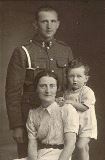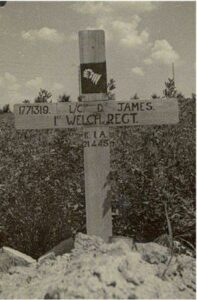The pretty village of Eglwyswrw lies in the north of Pembrokeshire, in the Hundred of Cemais. Originally only three men from the village were commemorated, on a small war memorial plaque which is located inside St Cristiolus Church, as most of the local men are commemorated on the war memorial at Crymych. Eglwyswrw and District Heritage Society researched and undertook a project to erect a new war memorial in the village to commemorate all of their local men together. This project finally came into fruition during June 2014, with the erection of a new war memorial outside the Church, which was unveiled by myself and dedicated by the Bishop of St. David’s on Sunday 10 August 2014. Many thanks to Paul Sambrook of Eglwyswrw for supplying the photographs of the grave of Joshua James, and the photograph of Oliver Rees, to Heather James for some of the photographs of the men, and to Will Thomas, of Eglwyswrw Heritage, who kindly kept me updated with details of the names of the men, with information about the project and for inviting me to carry out the unveiling. Following further research since the unveiling, a further four men have been discovered who were from the area and fell as a result of the war. A new addition to the memorial has recently been unveiled with the names of these four men on: Morris Bowen; Thomas Bowen; Tom Sallis; and Fred Waller, whilst a further two men who died in WW2 have been recently identified and added to the memorial: Benjamin Evans and Maurice Hemingway. Please see below for details.
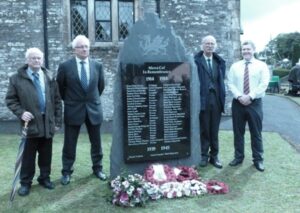
The Great War, 1914-1918
Morris Bowen, Stoker 1st Class, DEV/K/11695, Royal Navy. Morris was born on 22 January 1893, the son of William and Rachel Bowen, of Tycanol, Blaen-Y-ffos. He enlisted into the Royal Navy on 13 July 1911 and trained at HMS Vivid II before being posted aboard HMS Halcyon. Morris served aboard a number of ships over the coming years, and was aboard HMS Diana when war erupted. After several other postings he spent six months at HMS Idaho at Milford Haven before eventually joining the crew of the battlecruiser HMS Tiger. Morris survived the war but his health had begun to suffer and he took ill whilst still serving aboard Tiger. He returned home and died of tuberculosis on 27 May 1920, aged 26. Morris is buried in Blaen-Y-Ffos Baptist Chapelyard. His brother Thomas died a year earlier. Both brothers names have been added to the recently installed addition to the war memorial, following further research.
Thomas Bowen, Leading Stoker, K/11639 (DEV), Royal Navy. Thomas was born on 28 September 1890, the son of William and Rachel Bowen, of Tycanol, Blaen-Y-ffos. He enlisted into the Royal Navy on 20 June 1911 and trained at HMS Vivid II before being posted aboard HMS Active. Thomas served aboard a variety of ships over the coming years and like his brother Morris also spent six months at HMS Idaho at Milford Haven, before he eventually joined the crew of the light cruiser HMS Cairo. He took ill while Cairo was stationed at Hong Kong after the war and died in Hong Kong Military Hospital on 15 April 1921, aged 30. He is buried in Hong Kong Cemetery, China. His brother Morris died a year later. Both brothers names have been added to the recently installed addition to the war memorial, following further research.
Evan Owen Davies, Corporal, 30370, Middlesex Regiment. Evan was born in Eglwyswrw, and was raised by his grandparents, William and Phoebe Evans, at Palle, Eglwyswrw. He had trained as a pharmacist in London, and enlisted there into the Middlesex Regiment, with the Army Number 156. He transferred into the 46th Company, Machine Gun Corps, which was created by Royal Warrant, on 14 October 1915. Evan’s Company became attached to the 15th (Scottish) Division from 11 February 1916 onwards. The Division fought in the latter stages of the Somme Battles of 1916, and were in the middle of the Battle of Le Transloy when Evan was killed in Action, on 13 October 1916, aged 28. His body was lost on the Somme Battlefield, and so he is commemorated on the Thiepval Memorial, France.
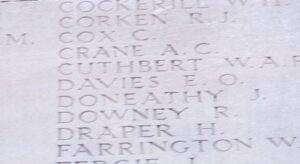
David Griffith Edwards, Lance Corporal, 39954, East Lancashire Regiment. David was the son of William and Ann Edwards, of New Inn, Blaenffos. He worked as a shop assistant prior to enlisting at Cardigan into the Army Service Corps, with the Service Number T/4/145707. He later transferred into the 2/5th Battalion, East Lancashire Regiment, which was attached to 126 Brigade, 42nd (East Lancs.) Division. On 6 May 1915 the Division landed at Cape Helles, Gallipoli, where they fought until evacuation in January 1916. They then spent twelve months in Egypt, and were moved to the Western Front in February 1917, taking over the line near Épehy then Havrincourt. In September they moved north to Ypres, where they fought through Third Ypres, until moving to the Coast in September to refit. November 1917 saw them moving to positions at Givenchy, where they remained until moving back south in early 1918. Here they faced the German Spring Offensive of 21 March 1918 on the Somme, and saw heavy fighting. David was killed in action during the Battle of Bapaume on 24 March 1918, aged 22 (SDGW shows 31 March). He has no known grave, and is commemorated on the Pozières Memorial, France.
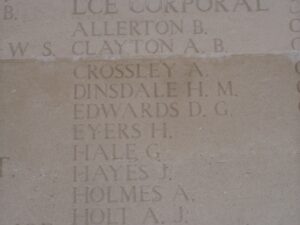
David Emrys George, Greaser, 912812, Mercantile Marine Reserve. Emrys was born in Laugharne in 1898, the son of Frank and Martha George. The family had moved to Pantyderi Mill, Blaenffos prior to 1911. Emrys served in the Mercantile Marine, aboard the River Class destroyer, HMS Derwent, which had been built by Hawthorn Leslie and launched in 1904. After commissioning she was initially attached to the East Coast Destroyer Flotilla, based at Harwich. By the time of the war, Derwent had joined the 9th Destroyer Flotilla, at Chatham, and was deployed on anti-submarine and counter-mine patrols. On 2 May 1917 she was working off the French coast, when she struck a mine which had been laid by the German submarine UC-26, and sank off Le Havre with the loss of 58 officers and men. Emrys was just 18 years old when he drowned that day, and is commemorated on the Plymouth Naval Memorial, Devon.
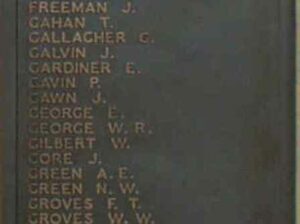
Stephen Penry George, Corporal, 2426, London Regiment. Stephen was born at Cardiff in 1882, the son of Stephen and Mary George. While Stephen himself never actually lived in Pembrokeshire, his father was a mariner from Meline, and by 1901 had moved the remainder of the family back there, setting up home at Dyffryn, Velindre, Crymych. Stephen resided at 2, Church Road, Brixton prior to the war and enlisted at Camberwell on 1 September 1914 into the 21st Battalion, London Regiment (1st Surrey Rifles). He landed in France with the battalion on 15 March 1915. The battalion was attached to 142 Brigade, 47th (2nd London) Division and saw action almost straight away, fighting at Aubers Ridge and Festubert. Later that summer, the division fought at the Battle of Loos. Stephen was wounded at Loos and returned home for treatment on 27 October. On 30 April 1916 Stephen returned to France, joining the division near Loos. The British had only just taken over this sector from the French, and the defences were wholly inadequate, so the men spent the coming weeks re-digging trenches. On 21 May the Germans launched an attack at the British positions south of Loos, to capture the vantage points of Vimy Ridge. Stephen was killed soon after, on 23 May 1916, aged 33. He has no known grave, and is commemorated on the Arras Memorial, France.
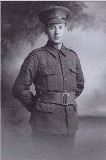
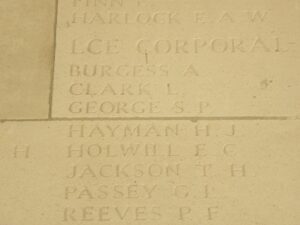
John Griffiths, Private, 302302, Manchester Regiment. John was born at Eglwyswrw, the son of Jacob and Mary Griffiths. The family later resided at Cwm, St. Dogmaels. John was the husband of Margaret Ann Griffiths, of Fairfield, St. Dogmaels. He enlisted at Cardiff into the 2/8th Battalion, Manchester Regiment, which was attached to 199 Brigade, 66th Division. The Division concentrated on the Western Front by 16 March 1917, moving to the Ypres sector. It was there, during the opening day of the Battle of Poelcappelle, that John was Killed in Action on 9 October 1917, aged 39. He is commemorated on the Tyne Cot Memorial, Belgium.
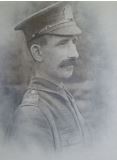
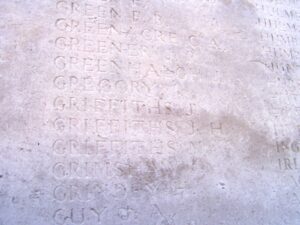
Joshua Clement James, Private, 202507, Welsh Regiment. Joshua was born at Eglwyswrw, the son of Samuel and Margaretta James, of Frochest Farm. He enlisted at Carmarthen into the 1/4th Battalion, Welsh Regiment, which was a Territorial Battalion, attached to 159 Brigade, 53rd (Welsh) Division. The division sailed for Alexandria in July 1915, and landed at Gallipoli on 9 August 1915. They suffered heavy casualties at Gallipoli, necessitating the Battalion to merge with the 1/5th Welsh to form the 4/5th Composite Battalion. After the evacuation of Gallipoli, the Division moved to Palestine. Joshua didn’t get sent overseas though. He Died on 23 February 1917, aged 29, and was buried in Eglwyswrw (St. Cristiolus) Churchyard.
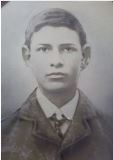
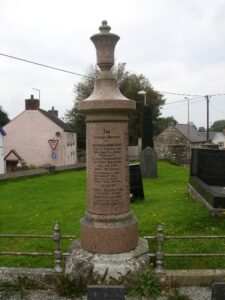
David Thomas Jones, Private, 1111, East Surrey Regiment. David was the son of John and Rachel Jones, of Hendy Farm, Blaenffos. He had married prior to the war, and lived with his wife Ann and their children at Church Cottage, Tonmawr, Pontrhydyfen, Glamorgan. David enlisted at Neath into the Army and was posted to the 7th Battalion, East Surrey Regiment, which was attached to 37 Brigade, 12th (Eastern) Division. The Division landed at Boulogne on 31 May 1915, and took over the line at Ploegsteert Wood. They then moved south and fought in the Battle of Loos, and the subsequent actions of the Hohenzollern Redoubt, and remained there until March 1916. David was wounded whilst in the line north of Loos, and was evacuated to the Military Hospital at Bethune for treatment. Sadly he died of his wounds here on 22 February 1916. David was 37 years old, and is buried at Bethune Town Cemetery, France.
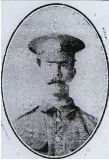
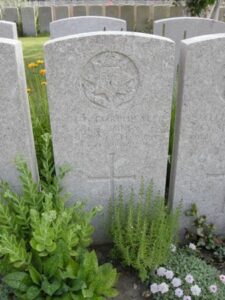
Griffith David Jones, Private, 53638, Royal Welsh Fusiliers. Griffith was the son of Evan and Mary Jones, of Trevigin Farm, Eglwyswrw. He enlisted at Carmarthen into the army, and was posted to France at some time late in 1916, joining the 1st Battalion, Royal Welsh Fusiliers, which was attached to 22 Brigade, 7th Division. Griffiths didn’t survive for long in France, as he was badly wounded when the 7th Division was following up the German retreat to the Hindenburg Line. He died on 30 March 1917, aged 30, and is commemorated on the Arras Memorial, France.
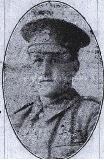
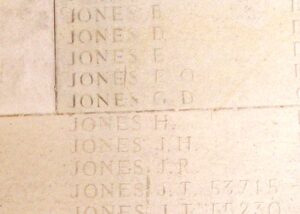
William Mathias Jones, Gunner, 118779, Royal Field Artillery. William was born in 1893, the son of Levi Thomas Jones and Anne Jones (nee Evans), of Nantgwyn Farm, Blaenffos. He was educated at Cardigan School and worked on his parents farm prior to the war. William enlisted at Cardigan into the Royal Artillery and was drafted to France in 1916, where joining C Battery, 108th Brigade, Royal Field Artillery, which was attached to the 24th Division. The Division had moved to France during August 1915 and marched to positions near Loos, where it took up reserve positions. Despite its inexperience, it was sent into action at Loos on 26 September 1915, and suffered terrible casualties. It was then withdrawn from the line, and didn’t see action until the summer of 1916 when it was moved to the Somme. The division then fought at Delville Wood and Guillemont, before moving north of Arras in early 1917. The 108th Brigade, Royal Field Artillery then left the 24th Division to join the 4th Army, moving to Les Brebis, where it remained until moving to positions near Kemmel at the end of May. On 7 June 1917 William’s battery saw heavy fighting during the Battle of Messines Ridge, and upon being relieved that night moved to a camp on the Vlamertinghe to Poperinghe Road. The 108th Brigade then moved to positions east of Ypres, near Potijze Wood by 27 July, in order to support the forthcoming Passchendaele offensive. The battery took part in the opening artillery barrage at dawn on 31 July 1917, the day which marked the beginning of what would turn out to be a terrible battle. William was still at work with his gun battery on the following day, 1 August 1917, when he was hit in the head by shrapnel from a German shell and was killed instantly. The 23-year-old is buried in Potijze Chateau Wood Cemetery, Belgium.
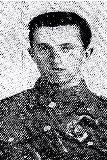
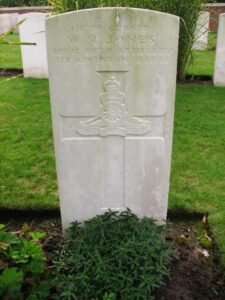
John Ladd, Private, 203599, Yorkshire Regiment. John was born at St. Dogmaels in 1878, the son of William and Phoebe Ladd. Prior to the war his family had moved to The Mount, Eglwyswrw, while John resided at 194, Ystrad Road, Pentre with his wife Edith Ann Ladd, and their four children. He enlisted at Pentre, Glamorgan, into the 2/4th Battalion, the Yorkshire Regiment, which had been formed on 4 September 1914 for Home Service. On 1 March 1916 they were attached to 189 Brigade, 63rd (Royal Naval) Division, and were transferred on 9 November 1916 to 220 Brigade, 73rd Division. The Division remained on Home Service, and John died of peritonitis at Pontypridd on 16 April 1917, aged 39, without having seen active service. He is buried at Rhondda (Treorchy) Cemetery.
Owen Ladd, Civilian. Owen was born at St. Dogmaels in 1882, the son of William and Phoebe Ladd. His parents later moved to The Mount, Eglwyswrw, while Owen had moved to Pentre, Rhondda, where his brother John resided. Owen had gone to Canada prior to the war and lived at 218, Carlton Street, Winnipeg, Manitoba, Canada, where he worked as a jeweller and had acted as secretary for a touring Welsh choir. His elder brother David James Ladd was already living in Winnipeg with his wife Allie Dee Ladd. Owen only lived in Manitoba for a couple of years. By 1915 he had decided to go home to live with his parents at Eglwyswrw, and sailed from New York aboard the White Star Liner R.M.S. Lusitania on 1 May 1915. Despite warnings of submarine activity, Lusitania rounded Ireland on 7 May without an escort and was torpedoed by the German submarine U-20. Owen was among 1,195 people aboard Lusitania who drowned in her subsequent sinking. His body was never recovered, so Owen does not have the luxury of a grave, nor a place on a memorial. He was 33 years old. A third brother, William Arthur Ladd, was awarded the Meritorious Service Medal for devotion to duty during the war.
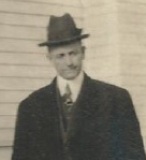
Walter Charles Little, Private, 320352, Welsh Regiment. Walter was the son of Walter and Mary Ann Little, of Springfield, Essex. After his father’s death in 1900, his mother remarried, moving to 3, Badeley Square, New Street, Chelmsford. Walter moved to West Wales and worked as a farm servant at Glandwr, Nevern prior to the war. He enlisted at Carmarthen into the Pembroke Yeomanry, with the Service Number 4688. The Pembroke Yeomanry formed at Tenby during August, 1914 as part of the South Wales Mounted Brigade, 1st Mounted Division. In 1916 they were sent to Egypt and guarded the Suez Canal Defences, but early in 1917 was disbanded, with the Battalion merging with the Glamorgan Yeomanry to form the 24th Battalion, Welsh Regiment, attached to 231 Brigade, 74th (Yeomanry) Division. The Division had formed in Egypt in January 1917 and had fought through the Palestinian Campaign, at the Battles of Gaza and the Battle and capture of Jerusalem. Due to the terrible casualties suffered by the British on the Western Front in March and April 1918 the Division was recalled to the Western Front, and arrived at Marseilles during May 1918. It fought at the Second Battle of Bapaume during the great offensive, and fought in Flanders before returning to the Somme and fighting at the Battle of Épehy, as part of the offensive towards the Hindenburg Line. Walter was wounded here, and evacuated to the Casualty Clearing Station at Doingt, where he sadly died of his wounds on 21 September 1918, aged 24. He is buried at Doingt Communal Cemetery Extension, France.
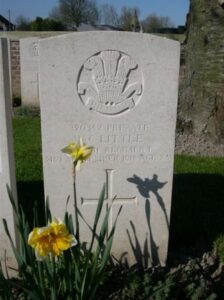
John Herbert Lloyd, Private, 38519, Gloucestershire Regiment. John, known as Herbert, was born in 1898, the son of David Lloyd and Elizabeth Lloyd (nee Bevan), of Rofftcharles, Eglwyswrw. He worked with his father at the family Butchers at East Street, Newport prior to enlisting at Carmarthen into the South Wales Borderers, but upon being drafted to France was transferred to the 8th Battalion, Gloucestershire Regiment, which was attached to 57 Brigade, 19th (Western) Division. The 19th Division had its baptism of fire during the Battle of Loos on 25 September 1915, when it had launched a diversionary assault near Givenchy. During the following summer the division played a major part in the opening of the Somme offensive, capturing Ovillers and La Boisselle. The division then moved to Ypres in March 1917, taking part in the Battle of Messines Ridge on 7 June 1917, then joined the great Passchendaele offensive. On 12 September the 8th Gloucesters moved into support positions near Zillebeke, then on 18 September relieved a battalion of the Rifle Brigade in the front line near St. Eloi. On 20 September 1917 the battalion took part in an assault against the German positions at J.31.a.5.3, and suffered heavy casualties. Herbert was killed in action that day. The 19-year-old has no known grave and is commemorated on the Tyne Cot Memorial, Belgium.
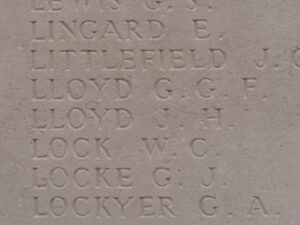
Idris Mathias, Rifleman, R/37992, King’s Royal Rifle Corps. Idris was born at Eglwyswrw in 1881, the son of David Mathias and Lydia Mathias (nee Thomas). Just after the turn of the century, he left the village to find work in Cardiff as a Draper’s Assistant, and in 1905 he married Hannah Howells, of Carmarthen. The couple settled at 29, Evansfield Road, Llandaff, where their two children, Winifred and David, were born. Hannah sadly died on 17 February 1913, and the following year Idris remarried to Anna Patricia Johnstone. Idris enlisted at Cardiff at some time in 1916 and after completing his training was drafted to France later that summer, joining the 13th Battalion, King’s Royal Rifle Corps, which was attached to 111 Brigade, 37th Division. The division had been on the Western Front since July 1915 and had taken part in its first major action during the diversionary attack on the Gommecourt Salient on the opening day of the Battle of the Somme, on 1 July 1916. Two of the Division’s infantry Brigades, the 111th and the 112th, and the Divisional pioneers were then attached to the 34th Division, which had suffered very heavy losses in the attack on La Boiselle in the opening phase of the Somme battle, between 6 July and 22 August 1916. These brigades then saw further fighting before rejoining the 37th Division in time to take part in the Battle of the Ancre. The division transferred to the Arras Sector the following spring and took part in the First Battle of the Scarpe, capturing the village of Monchy le Preux. After further fighting during the Second Battle of the Scarpe, and the Battle of Arleux, the division was withdrawn from the Arras Sector in May 1917 and transferred north to the Ypres Salient, taking over positions near Wytschaete by the end of the month. After two weeks in the line there, the 13th KRRC was relieved and moved to Bailleul, to undergo a training regime, in preparation for the forthcoming Passchendaele offensive. On 26 July the battalion received sudden warning to move back to Wytschaete and relieved 63 Brigade in the line at Derry House. The battalion then spent two days carrying out carrying work, prior to launching a large scale trench raid against the Germans on the night of 28/29 July. At 03.40 on the morning of 29 July 1917 an artillery barrage opened up along the German lines, and the two parties, consisting of 47 men led by an officer, climbed out of their trenches, crossing No Man’s Land. Both parties soon came under heavy rifle and grenade fire, but nonetheless reached their objectives and gained a lot of intelligence, before returning to their own lines. Idris was among seven casualties suffered during the raid, being killed sometime during the morning of 29 July 1917. The 36-year-old has no known grave and is commemorated on the Menin Gate Memorial at Ypres.
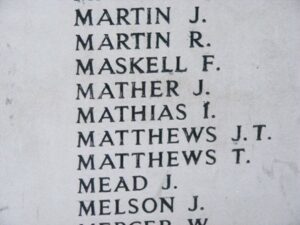
James Mathias, Sapper, 151206, Royal Engineers. James was born in Eglwyswrw in about 1881, the son of George and Rebecca Mathias. He married Octavia Morris Johns at Cardigan on 15 December 1907, and the couple set up home at Boncath. Prior to the war the family moved to 5, Dogbrook Terrace, Ammanford, where James found work as a coalminer. He enlisted there into the 15th Battalion, Welsh Regiment, which was known as the Carmarthen Pals Battalion, and was attached to 114 Brigade, 38th (Welsh) Division. He landed in France with the battalion on 5 December 1915, but was then attached to the Royal Engineers as a tunnellers mate. At the end of 1916 he joined the 170th Tunnelling Company, Royal Engineers, then on 1 February 1917 was posted to the 255th Tunnelling Company, Royal Engineers. The 255th Company was used at Vimy, to dig the Grange Subway, and constructing underground water reservoirs near Souchez. They were moved to Givenchy in late 1917, and then in April 1918 were in Flanders when the great German Offensive began. They were urgently sent to help consolidate Front Line trenches to try and stem the German advances, and it was during this maelstrom that James was mortally wounded. He died of his wounds in the Hospital at Lijssenthoek, west of Ypres, on 31 May 1918. The 37-year-old is buried in Lijssenthoek Military Cemetery, Belgium.
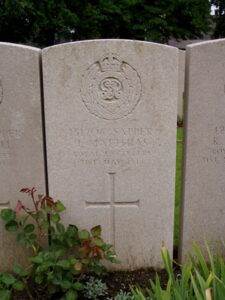
John Owens, Private, 7/45055, South Wales Borderers. John was born at Eglwyswrw in 1897, the son of Thomas and Ellen Owens. At some time after 1901 the family had moved to Rock Cottage, Pantygrwndy Fach, near Cardigan. John worked as a farm labourer at Eglwyswrw before enlisting at Carmarthen into the Welsh Regiment. He then spent some time with the Leinster Regiment before being posted to the 7th Battalion, South Wales Borderers, which was attached to 67 Brigade, 22nd Division. John joined the battalion in Salonika. He was killed in action during the Battle of Doiran on 18 September 1918, aged 21. John is buried in Doiran Military Cemetery, Salonika.
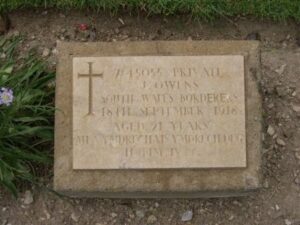
Stephen George Peregrine, Private, 70205, Machine Gun Corps. Stephen was born in Meline, Pembrokeshire in 1878, the son of Stephen George Peregrine and Maria Peregrine. By 1904 he was residing at Brynamman, and that year married Margaret Hopkins, of 22, Park Road, Brynamman. Stephen enlisted at Brynamman into the 9th Battalion, Welsh Regiment on 26 May 1915. He joined the battalion in France later that year, as part of a number of reinforcements after the Battle of Loos, and was transferred into the 58th Company, Machine Gun Corps upon the organisation of the MGC in 1916. The 58th Company was attached to the 19th (Western) Division, and Stephen would have served through the Battles of the Somme in 1916. The division fought at Messines, Polygon Wood, Broodseinde, Poelcappelle and Passchendaele during Third Ypres, and gained itself a reputation as a fine fighting force. During the winter of 1917-1918 the division was stationed near Bapaume, and was hit by the German offensive on 21 March 1918. The Division suffered heavily during the first few days of the attack, and Stephen was Killed in Action during the defence of Beugny, on 26 March 1918, aged 39. He is buried at Delsaux Farm Cemetery, Beugny, France.
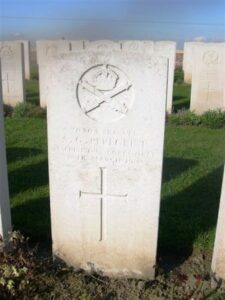
Griffith Phillips, Private, 56891, Welsh Regiment. Griffith was born in Eglwyswrw, the son of Evan and Ellen Phillips, of Pantycelyn. He enlisted at Neath into the Pembroke Yeomanry on 9 December 1915, and on 4 August 1916 was posted to France, joining the 13th Battalion, Welsh Regiment, which was attached to 114 Brigade, 38th (Welsh) Division. The Division landed in France in December, 1915, and was blooded at the Battle of Mametz Wood, where it suffered so badly that it was not used again for a year. It took part in the Passchendaele Offensive, at the Battle of Pilckem Ridge, on 31 July 1917, and then fought at Langemarck. The Division was in the French Flanders sector at the end of 1917, and it was during a tour in the front line near Fleurbaix that Griffith was killed in action, on 2 January 1918, aged 37. He is buried in Rue-Petillon Military Cemetery, France.
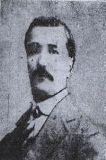
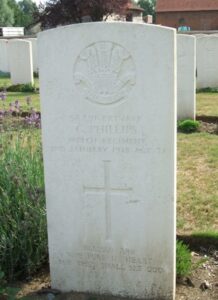
Haydn Phillips, Private, 29933, South Wales Borderers. Haydn was the son of John and Mary Phillips, of Shop Issaf, Eglwyswrw. He enlisted at Porth, into the South Wales Borderers, and was posted to France early in 1916, joining the 2nd Battalion, South Wales Borderers, which had moved to France in March 1916 from Egypt, with 87 Brigade, 29th Division. The Battalion had fought at Tsingtao, China, and had taken part in the Gallipoli campaign, landing at Cape Helles on 25 April 1915. The battalion saw heavy losses on 1 July 1916 at Beaumont Hamel, and after rebuilding strength, saw heavy fighting on the Somme in 1916. During 1917 the battalion fought at, Passchendaele and Cambrai, but at some time during the fighting in France, Haydn took ill, and was shipped back to Hospital in the UK. He died in hospital at Whitechapel, London on 18 March 1918, aged 21, and is buried in Pontyglazier (Bethabara) Baptist Chapelyard.
Oliver James Rees, Private, 32954, Welsh Regiment. Oliver was born in 1880, the son of John and Mary Rees, of Glyn, Eglwyswrw. By 1901 he was residing at Pontycymmer, with Ellen Jones, and worked as a coalminer there. In 1903 he married his widowed landlady, Ellen, of 32, Bridgend Road, Pontycymmer. Oliver enlisted at Bridgend into the 9th Battalion, Welsh Regiment. The battalion was attached to 58 Brigade, 19th (Western) Division, and landed in France during July 1915, taking up a sector north of Loos, near Givenchy. It was during the Divisions first major engagement, at the Battle of Loos, that Oliver was Killed in Action on 25 September 1915, aged 35. He is commemorated on the Loos Memorial, France.
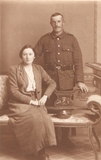
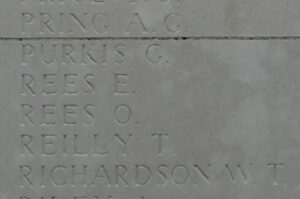
Thomas Sallis, Driver, T2/SR/01274, Army Service Corps. Thomas, known as Tom, was the son of John and Anne Sallis, of Eglwyswrw. He was working as a tailor at Penrhiwceiber prior to the war. Tom enlisted into the Army Service Corps on 6 October 1914 and served in France from 15 January 1915. Tom took ill during the summer of 1917 and was discharged from the army as medically unfit on 9 October 1917. He returned home to Eglwyswrw where he died of tuberculosis on 20 July 1919, aged 25 and was buried in Bethabara Chapelyard, Pontyglasier. He is at present a ‘Forgotten Soldier’ who is not currently commemorated by the CWGC, but following further research I have presented evidence to them in order to gain his official commemoration, and his name has also recently been added to the new addition to the Eglwyswrw Memorial.
David Thomas, Sapper, 448274, Royal Engineers. David was born at Eglwyswrw in 1887, the son of Thomas and Ellen Thomas. The family moved to 102, Sandy Road, Llanelli prior to 1911. David married Agnes Thomas in 1908, and the couple resided at 9, Marine Street, Llanelli. He enlisted at Llanelli into the Royal Engineers, and served with the 436th Field Company. David was killed in action during the Battle of Nabi Samweil on 26 November 1917, aged 30, and is remembered on the Jerusalem Memorial, Israel.
Simon Thomas, Sapper, 82332, Royal Engineers. Simon was the son of Daniel and Mary Thomas, of Pontsaeson, Eglwyswrw. He was living at Neath by 1901, and had married Blodwen Rowlands at Glynneath in 1902, the couple later having two children. Simon enlisted at Neath into the Royal Engineers. He was posted to the 124th Field Company, attached to the 38th (Welsh) Division. Simon landed in France with his unit on 3 December 1915, and moved with the Division to the Fleurbaix sector, near Armentieres. This was known as the ‘Nursery Sector’, which was a quieter sector of the Western Front, used for blooding new troops into trench warfare. Although quieter, it was far from safe, and Simon was killed in action here on 3 April 1916, aged 39. He has no known grave, and is commemorated on the Loos Memorial, France.
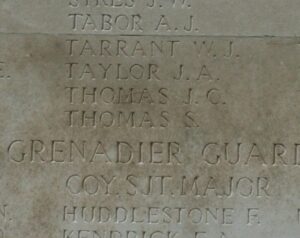
Thomas Walter Thomas, Lance Corporal, 28552, Royal Inniskilling Fusiliers. Thomas was the son of Thomas and Hannah Thomas, of Pencnwcmawr, Eglwyswrw. He enlisted at Leamington into the Welsh Regiment, with the Regimental Number 39547. Thomas later transferred into the 7th Battalion, Royal Inniskilling Fusiliers, attached to 49 Brigade, 16th (Irish) Division. During December 1915 the Division moved to France and concentrated in the Bethune area. They were still in the area when Thomas was killed on 27 April 1916, aged 23. He has no known grave, and is commemorated on the Loos Memorial, France.
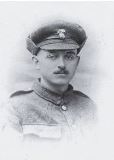
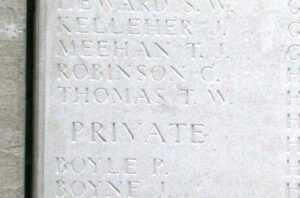
Fred Waller, Private, 2522, Welsh Regiment. Fred was born in London in around 1897, the son of Emily Caroline Waller. He had moved to Eglwyswrw to work at Pencelly Farm by 1911 and enlisted at Cardigan soon after the outbreak of war, joining the 4th Battalion, Welsh Regiment. He was posted to the Mediterranean with the 1st/4th Welsh in June 1915 and landed with the battalion at Gallipoli on 7 August 1915, attached to 159 Brigade, 53rd (Welsh) Division. The division was ordered to move forwards and disappeared ‘into the bush’ but quickly became disorganised due to a lack of maps red was killed in action here on 10 August 1915, aged 18. He has no known grave and is commemorated on the Helles Memorial, Gallipoli. Following further research, Fred’s name has been added to the new extension to the Eglwyswrw memorial.
Bryn Gwynne Williams, Private, 67515, Cheshire Regiment. Bryn was the son of John and Mary Williams, of Deri House, Eglwyswrw. He worked as a Bank Clerk, and was living at 105, Priory Street, Carmarthen by 1917. He enlisted at Carmarthen into the Welsh Regiment on 10 September 1917. Bryn was then posted to the 48th Training Battalion, and on 3 April 1918 was posted to France, joining the 9th Battalion, Cheshire Regiment, which was attached to 56 Brigade, 19th (Western) Division. The Division was in Flanders, rebuilding from its mauling on the Somme, following the German offensive which began on 21 March 1918. It had then been sent to Messines, to rebuild, but was caught up in the German attack at Messines, which was launched on 7 April 1918 by the Germans. Bryn by now had become dangerously ill, and had been evacuated to the Base Hospital at Etaples for treatment. He sadly died there of pneumonia on 23 April 1918, aged 18. He is buried at Étaples Military Cemetery, France.
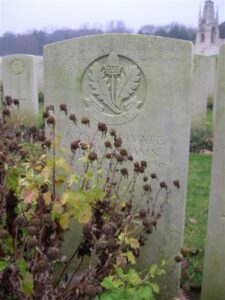
World War Two, 1939-1945
Benjamin Roderick Evans, Master, Merchant Navy. Benjamin was born at Cilgerran on 30 May 1890, the son of William and Sarah Evans. His mother was from Eglwyswrw. Benjamin left home as a young man to go to sea, joining the Mercantile Marine, and on 5 November 1910 gained his certificate as Second Mate, then qualifying as Master in April 1915. He served at sea throughout the First World War, making his home on land at Pantyderw, Blaenffos. Benjamin continued to serve at sea over the coming years, marrying Morfydd Rowland Jones in 1933, and the couple made their home at Maes-y-Llan, Boncath. Following the outbreak of the Second World War, Benjamin was Master of the London registered MV King Lud. On 8 June 1942, King Lud was sailing through the Mozambique Channel, on passage from New York to Bombay carrying military personnel and government stores, when she was torpedoed and sunk by the Japanese submarine I-20. Benjamin was 52 years old when he died in the sinking of his ship that day. He has no known grave but the sea, so is commemorated on the Tower Hill Memorial, London. His name has recently been added to the Eglwyswrw war memorial.

Maurice Hemingway, MiD, Flight Lieutenant, 45892, Royal Air Force. Maurice was born on 7 April 1908, the son of Robert Hemingway and Clara Novello Hemingway (nee Shillito), of 3, Barley Street, Bradford. He worked as a bookkeeper after leaving school, and on 17 April 1933 married Louie Chappell at Carlinghow Church, Yorkshire. When war broke out, Maurice enlisted into the Royal Air Force and, being a bookkeeper, was commissioned as a Pilot Officer in August 1941 before being posted to RAF Aberporth, where he served as the station accountant. He took up residence at Glanyrafon, Brynberian, near Crymych. Maurice was promoted to Flying Officer in August 1942, then promoted to Flight Lieutenant in January 1944. He continued to serve at Aberporth until falling ill in the spring of 1944 and was diagnosed as suffering from cancer, so was forced to relinquish his commission. Maurice died of cancer at his home at Glanyrafon, Brynberian on 17 September 1944, aged 36. He was cremated at Pontypridd Crematorium. His widow, Louie, returned to her native Mirfield, Yorkshire, where she lived until her death in 1978. Maurice was not commemorated locally, but his name has recently been added to the Eglwyswrw war memorial.
Daniel Alcfryn James, Private, 1771319, Welch Regiment. Daniel was the son of Joseph and Lena James, of Eglwyswrw, and the husband of Daisy Maude James, of Newport, Pembrokeshire. He served with the 1st Battalion, Welch Regiment. The battalion served in the North African campaign after rebuilding following heavy casualties during the fall of Crete, and suffered terribly at Benghazi, losing almost 500 men. It then rebuilt, and took part in the subsequent invasion of Sicily and Italy. The 1st Welch then transferred to the elite 1st Guards Brigade, and took part in heavy fighting around the Argenta Gap. Dan was killed in Italy during the drive towards the River Po on 21 April 1945, aged 28. He is buried in Faenza War Cemetery, Italy.
